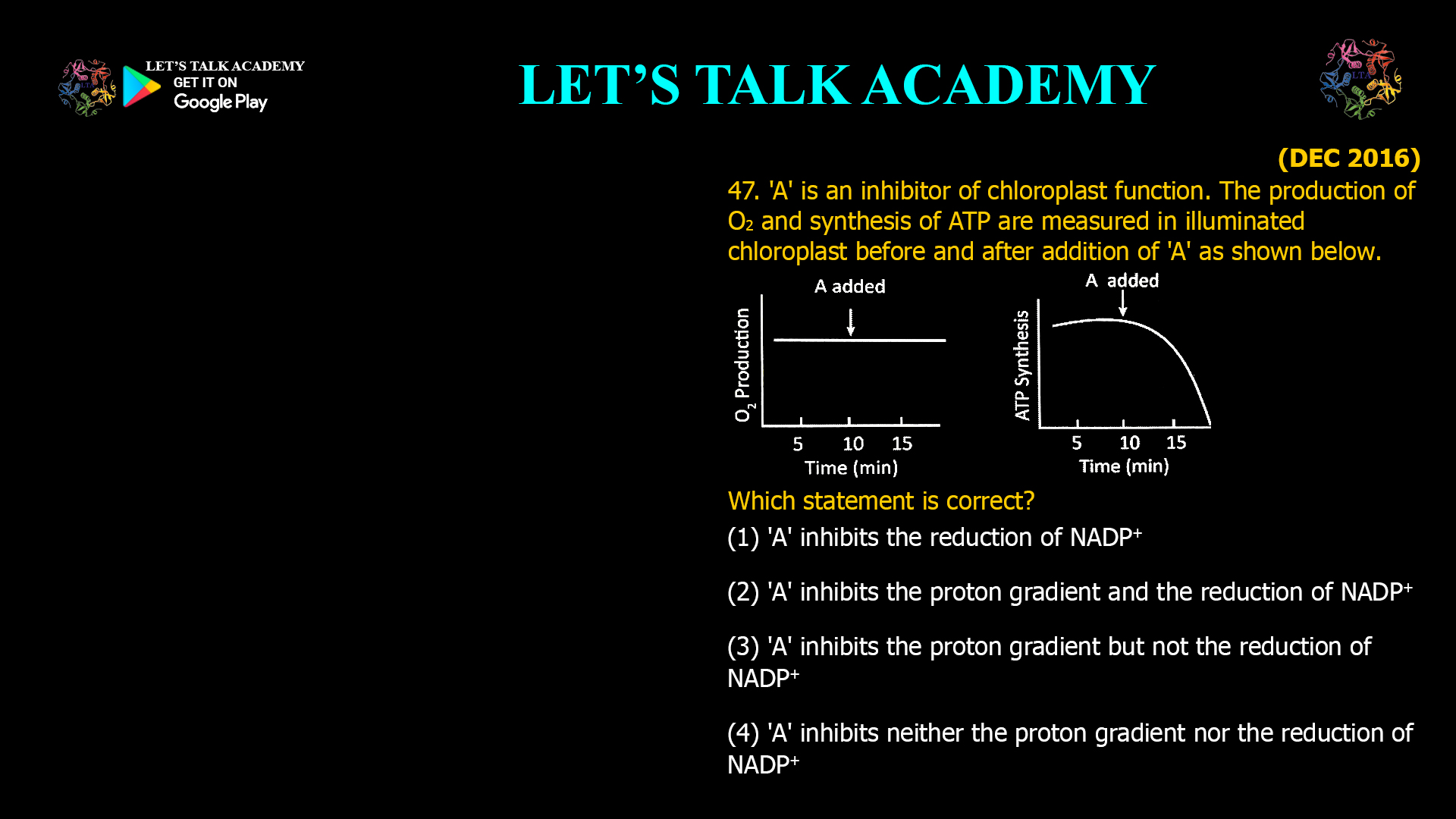47. ‘A’ is an inhibitor of chloroplast function. The production of O2 and synthesis of ATP are measured in illuminated chloroplast before and after addition of ‘A’ as shown below.
Which statement is correct?
(1) ‘A’ inhibits the reduction of NADP+
(2) ‘A’ inhibits the proton gradient and the reduction of NADP+
(3) ‘A’ inhibits the proton gradient but not the reduction of NADP+
(4) ‘A’ inhibits neither the proton gradient nor the reduction of NADP+
Based on the experimental result shown: after the addition of inhibitor ‘A’, O₂ production continues as before, but ATP synthesis drops sharply. This means ‘A’ does not block electron flow (O₂ evolution is a marker for normal electron transport/reduction of NADP⁺), but does dissipate the proton gradient necessary for ATP synthesis.
The correct answer is (3): ‘A’ inhibits the proton gradient but not the reduction of NADP⁺.
Chloroplast Inhibitors: Impact on Electron Transport and ATP Synthesis
Introduction
Key phrase: chloroplast inhibitor ATP synthesis proton gradient NADP+ reduction electron transport experiment
In this classic experiment, the inhibitor does not affect O₂ evolution (electron flow and NADP⁺ reduction continue normally) but rapidly blocks ATP synthesis, implying it destroys the trans-thylakoid proton gradient without impeding photosynthetic electron transport.
Explanation of Each Option
-
(1) ‘A’ inhibits the reduction of NADP⁺
-
Incorrect. Steady O₂ evolution indicates that the photosynthetic electron transport chain, including NADP⁺ reduction, is unblocked.
-
-
(2) ‘A’ inhibits the proton gradient and the reduction of NADP⁺
-
Incorrect. O₂ is still produced, meaning electrons continue to flow and NADP⁺ is being reduced. Only ATP synthesis is affected, not electron transport.
-
-
(3) ‘A’ inhibits the proton gradient but not the reduction of NADP⁺
-
Correct. The loss of ATP synthesis while O₂ evolution continues shows that the inhibitor (likely an uncoupler or ionophore) collapses or dissipates the proton gradient across the thylakoid membrane but does not block electron flow or NADP⁺ reduction, which are coupled to O₂ evolution.
-
-
(4) ‘A’ inhibits neither the proton gradient nor the reduction of NADP⁺
-
Incorrect. The sharp drop in ATP synthesis after adding ‘A’ rules out this option. ATP synthesis depends on a proton gradient.
-
Key Facts: Experimental Analysis of Chloroplast Inhibitor
-
O₂ evolution indicates ongoing electron flow and NADP⁺ reduction.
-
Inhibitor blocks ATP synthesis by dissipating the proton gradient across the thylakoid.
-
Uncouplers (like CCCP or gramicidin) behave this way in laboratory experiments.



